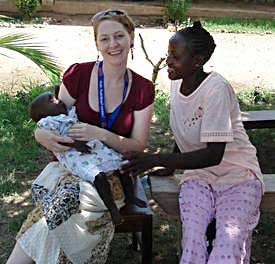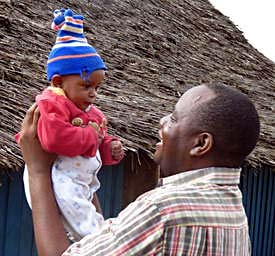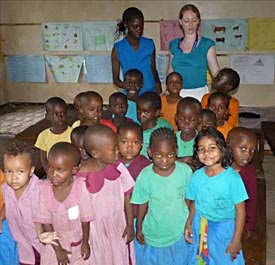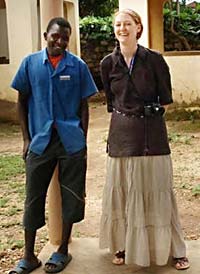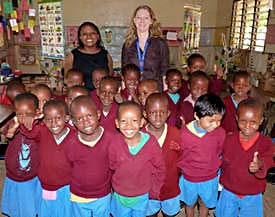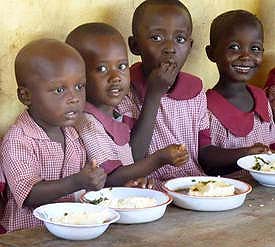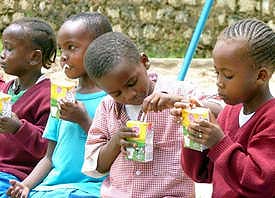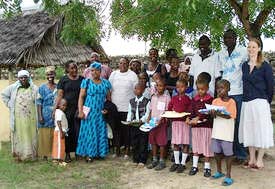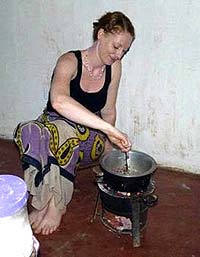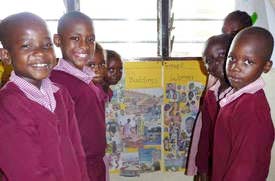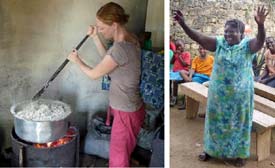| |
- My visit to Kenya in October 2011
- By Irulan Horner
-
Preparation
My name is Irulan, I work for a company called Reconstruct. As an organisation who cares about children in care in England, the directors felt that supporting the KiD charity matched the company philosophy of supporting children through education and providing positive adult role models.
I was privileged to spend a month with the KiD school in Kenya working as a volunteer, learning more about the children, the staff and the Kenyan way of life. I was proud to go as an ambassador of Reconstruct and the employees who support the KiD project through sponsorship of pupils and a teacher at KiD.
However, before I could embark on my exciting adventure there was a lot of preparation to be done. First there was raising the money needed through sponsorship. That involved running a half marathon, a pub quiz for my friends and work colleagues, and a Body Shop party. Eventually, after nine months of fundraising I had enough money. I booked my flight, applied for my visa, had my many injections, got my malaria tablets and packed my bag. I was finally ready to embark on a trip of a life time.
-
Arrival
On arriving in Kenya I was very nervous about meeting everyone and actually teaching the children something useful – I had no idea what to expect.
The first face I saw was that of Edward - he greeted me with a big smile and I started to relax. The sights, sounds and smells of Kenya all around me on the journey from Mombasa to Diani Beach were all new and exciting.
I arrived at the school on a very special day – Thanks Giving. The school play-ground was full of children playing and parents chatting, food for all and plenty of fizzy drinks. I was immediately invited to join the party and it wasn’t long before I was holding a baby in my arms and eating chicken, rice and salad with everyone.
After the meal finished the school manger Joshua showed me around the village – White House. The people of White House live in huts made from palm leaves, with dirt floors, no refuse collection, no sanitation, no running water and only some have electricity. I was in awe at the fact that not only do they live in the face of such adversity; they do it with such a cheerful disposition. The streets of the village were filled with children running and playing, the sound of friendly conversations and the smell of cooking filled the air. Living in a hut means there is no kitchen as such, just a ‘jiko’ (charcoal stove) on the floor, so most of the cooking is done alfresco.
Joshua took me to the local “restaurant” – a simple place with a few wooden tables and plastic chairs. By the light of the one and only electric bulb the restaurant owner and his wife produce tasty food for many people from the village. After a delicious meal I finally got to go to bed after my first very long day in Kenya.
-
My 1st week as ‘Teacher Irulan’
I spent my first week assisting teacher Maryam with her class of 21 children aged about 3-4. The day went like this:
At 6am the school bus takes the older pupils to another school in Ukunda, the town further in land from Diani Beach. On its return journey the bus drops off the children who live too far away to be able to walk to school.
At 7.30am everyone gathers for assembly, the Kenyan flag is raised, the national anthem sung and uniforms are inspected. The teachers say good morning to the classes and tell them what they will be learning about on that day.
After assembly classes start and are very different from what I experienced as a child. The children sing – a lot! They love it! I taught them ‘Old MacDonald Has a Farm’ and I learnt that animals in Kenya make very different sounds to those in England. Old MacDonald now has a dog who howls like a wolf – later that evening I learnt that this was indeed true. Once one dog starts the night sky is soon filled with the howls of many.
The children are taught in English and learn through repetition. The class are learning letters of the alphabet by saying them phonetically and how to read 3-4 letter words containing the letter a. So: “The man has a van. My dad has a bag.” They are counting and writing the number 1-10. Their enjoyment of school and the opportunity to learn is obvious.
Eventually we got around to drawing – this week was all about “cooking utensils”. First we visited the kitchen and looked at all the utensils. Teacher Maryam asked the children to name the items in Swahili and then she repeated them in English. On returning to the class room I drew the items on the board and the children told me the names of them in English.
Once Teacher Maryam realised I could draw, I was tasked with producing “posters” of all the items the children were learning. I drew pages and pages of cooking utensils, things we wear, domestic animals, art of the body, family members... I found I had a talent that could help the school. I am so pleased to think that all the posters I created will be on the walls of the KiD class rooms for many years to come.
I really enjoyed my first week with the KG1 class, they are delightful children with big smiles and bright eyes who made me feel very welcome. I couldn’t help but have a few favourites – the cheeky ones mostly.
At the weekend I was shown around by Peter, the school’s handyman and an ex-pupil of KiD who is now training to be an electrician. He took me down the coast to the beach. We visited the local shops and he introduced me to many of the villagers - giving me a good insight into the Kenyan way of life. One evening I had a lesson on how to cook japatis and chicken with tomatoes and potatoes. There was so much food that we shared it with the other families who live on the school compound. I have tried to make japatis at home in England but have never managed to get them to taste as good as they did when Peter made them for me.
That weekend I also had a long conversation with Manager Joshua about his hopes and dreams for the future of the KiD school. We spoke about the children, their prospects for the future, the development of the community they live in and the very important role that education plays in all of this. It was very touching to see such generosity of spirit and faith in the future.
-
My 2nd week, teaching KG2
There are 23 children in KG2, ages about 5-6. Teacher Agnes leads this class with an amazing balance of respect and love. The children clearly adore her and they are disciplined and polite in their behaviour as a result. They work hard at their studies and produce good work on the whole. My main job was to mark all the homework, with a red pen! I felt very important. It amazed me that the children manage to do their homework so well in such adverse conditions. When I first started this task I was surprised at the state of their exercise books. The parents cover the books with the brown paper from packets of flour, and then the children adorn this with lots of red dirt, the natural colour of the soil in Diani. Once I had visited some of the children’s homes, and witnessed them crouching on the floor, with a paraffin lamp or candle to see with, writing in their books with a blunt pencil and often with no rubber to correct their mistakes, then I realised why their school books came back a little grubby.
It rained this week, rain like I have never seen before. It was amazing to sit on the veranda outside the school building and watch the rain come down. The mayflies came out, 100s of them, birds swooped across the sky eating them in mid-air, and the chickens joined in the feast on ground level.
When the rain subsided I paid a visit to the village. Most of the huts were flooded; people’s homes had a ‘river’ running through them. The villagers just put their umbrellas up, their plastic shoes on, tied scarves around their heads and carried on with their lives.
I was told that this much rain was unusual for this time of year, however in the Spring, when the “big” rains come, this downpour would look like a mere shower.
So life at the school carried on despite the rain. “Grandmother” Ruth, the school cook, kept on cooking porridge in the morning and rice and beans at lunch. The children usually ate in the “dining room”, but due to the weather they would bring a chair or a bench out onto the covered veranda and sit in a higgledy piggledy row, eating away with their usual glee. Some of the children only get fed at school, as their parents don’t have enough food at home for them. Not once did I hear ‘I don’t like that’ or ‘I’m not hungry’. Every day every plate was cleared and every child was fed and happy. The teachers show them how to wash their hands before and after eating. All the children would line up patiently for their food and return their plates to be washed up afterwards without being asked.
As a member of staff at break times with I would sit on a small child’s chair the other teachers around a low table and the children would bring our food and tea to us. Over lunch we would talk about life in Kenya. We spoke about children and how to do best by them; we discussed some of the issues they face as they grow up. How the lack of education and knowledge can lead to teenage pregnancy, drug and alcohol abuse, sexually transmitted diseases, domestic violence and malnutrition. These are the realities that the people of White House face in overwhelming numbers and on a daily basis. Through education and guidance from knowledgeable adults these children have a better chance of getting an education which can lead them to employment and the ability to support themselves and a family of their own.
The tourist industry is vital to the way of life in Diani Beach, providing jobs such as security guards, waiters, gardeners, beauticians, builders, artists, sculptors, chefs, musicians, entertainers, safari guides, market sellers, taxi drivers and so much more. The violence in Somalia erupted whilst I was there, filling everyone with fear and uncertainty. Bombings in Mombasa, tourists kidnapped, soldiers tracking down pirates - all of this bad news results in a drop in tourism, making life even harder for many Kenyans in the coastal areas. Even though these military standoffs with the bandits are many miles away from the tranquillity of Diani Beach, keeping the peace and stability is so important to the future of the children and their prospects for being able to make a living.
I decided to hold a drawing competition for the children, with prizes for my favourite ones. I started by making some suggestions and drawing animals on the board so they could guess what they were. Then they joined in and started to copy them. Eventually they drew their own favourite animal and coloured it in. It was very hard to judge the competition, the wide selection of lions, elephants, gazelles, crocodiles, goats and cows was immense. Some with three legs, others with six, some came in green or blue, others with pink horns or red ears. An amazing array of creativity from children who usually only draw what is in their books or as instructed by their teacher. It was lovely to see them be free with their talent and draw what they liked. The prizes were colouring books, paints, pens and pencils; treasured items for children who like to draw and colour. I hope my love of expressing myself through art rubs off on them.
The sponsors Heinz and Heike paid the school a visit. This was an exciting time for the children and the staff. They wrote a song for them, which was performed with gusto by all. As a treat the sponsors bought the children milk and biscuits. It was lovely to see the children so delighted by something so simple.
On my second weekend I met with all of the “Reconstruct” sponsored children. Through the company, friends and family there are a number of individuals who sponsor children who attend the kindergarten and also the Rainbow school in Ukunda. Meeting with all of the children and some of their parents was a real pleasure. They all came dressed up for the occasion and wearing their biggest smiles. I asked the children some questions about themselves and their hopes and dreams for the future. They were all very shy of me and often wouldn’t answer, but Teacher Agnes “translated” my English into “Kenyan-English” (English with a Kenyan accent) and then they answered the questions. I wrote down their replies and once I returned home I sent this information and a picture from each child, to their sponsor. I also delivered some gifts and letters from the children, which was such a lovely thing to do, as it provided the sponsors with a real picture of what life is like for the children and their families in Kenya.
After the ‘question time’ we all got together to take some lovely photos and I gave each child a gift from their sponsor. The children were very happy, playing with their toys, looking at their new pencil cases and reading their books. I also gave them a letter from their sponsor, which we read together. It was a lovely experience for me, exchanging news and stories from England to Kenya and back again.
I went to Teacher Maryam’s house in the evening. She lives on-site with her husband and five children. Her two eldest boys are away at school, the younger three live with her. I had agreed to make them dinner. I wanted to make them some Western food, as a thank you for all the times they had fed me. So pasta with a tomato sauce and mushrooms was on the menu. It turns out that Kenyans don’t eat mushrooms, they are considered a weed. I managed to get some tinned ones, and also some cheese to go on top. I didn’t have a grater but I compromised by cutting the cheese up very small. Cooking for eight people on one small charcoal fire whilst sat on the floor was a new skill for me – it took much longer than I had bargained for. I eventually fed five hungry children and three hungry adults after two hours of prepping and cooking. On tasting the food their faces mirrored some of the apprehension I felt when sampling the Kenyan food. But they ate every last bit and told me how lovely it was. I hope they weren’t just being polite. ?
Since returning to England I have become sponsor to Maryam’s youngest daughter, Patience. She now attends the KiD school, with Agnes as her teacher. I know she will do well and I am sure she will sing loudly, eat plenty, count clearly, spell correctly, read beautifully and play every day. It fills me with happiness to know that I had the pleasure of actually meeting my sponsored child, making her ‘real’, funny and sweet to me.
-
My 3rd week, teaching Class 1
Teacher Elijah has 19 pupils between the ages of about 7-9. Some of them are unsure of how old they are. In class one they are learning lots of subjects, including English, Maths, Science, Swahili (the Kenyan language), Religious Studies and Geography.
I decided to stick with what I know best and taught them Art and Creativity. I asked the children to cut out pictures from old newspapers on a variety of subjects, such as food, children, houses, transport, sports people etc. Then they stuck them onto posters under the different headings. Most of the children had never used scissors or glue before – so it was a learning curve for them. Unfortunately there weren’t enough pairs of scissors or glue sticks for one each (I was on a budget) and sharing was not something familiar to them. So I had to be very firm with them about taking turns- a steep learning curve for me!
So after three weeks my last class was over, one week spent with each of them. I enjoyed my experience with each class, but I have to admit the littlest ones made me smile the most. They are so eager to learn, they love to play, sing, eat, draw, write, read and count – life for them is still so fresh and new. A skill we could all do with reminding ourselves of sometimes.
I was fortunate enough to go on safari at the weekend. It was an amazing experience seeing all of the Kenyan wildlife at a reserve further in-land. The sight of elephants, lions, zebras, giraffes, gazelles and so much more in the wild was breath taking. It is the case that most of the children in the school have never seen these animals for themselves, safaris being very expensive and only designed to be accessed by the tourists. So with this knowledge, for me it was even more of a privilege to have this opportunity.
-
My 4th week at KiD
I had the opportunity to spend a few days in the “kitchen” with Nyanya (Kenyan for Grandmother) which is what all the children call the cook.
It amazed me that one woman could produce so much food for so many little hungry mouths. She starts work at 6am, asking porridge for breakfast and cleaning the beans for lunch. She even used to make the time to bring me breakfast of hot black tea and bread and butter every morning.
I helped serve the porridge at break time, 9am. The children thought this was very funny, and called me Nyanya too.
Cooking all of the food on a big charcoal jiko in a surfuria (a giant cooking pot) is the moist exhausting job I did in Kenya. The heat really gets to you - stirring the rice, cutting the onions, washing the pots and serving the food becomes a really hard task. I was so tired by the end of each day that I begged the school management to get Nyanya some help. I’m happy to say they now have two cooks.
Nyanya Ruth is an amazing woman, who cares greatly about the children, as all the staff do. It was an honour to meet her and to witness her gusto for life and sunny attitude was a true inspiration to me.
I planned a farewell party for my departure, with cake, fizzy drinks, presents, balloons and games. The cake went down a treat – the Kenyan tradition of putting icing on each other’s cheeks was a new one on me. We all looked very silly. The children played apple bobbing and find the sweet in a bowl of flour – all accompanied by screams of laughter – so I’m pretty sure they enjoyed it. I gave the gift of a tooth brush to each child and got a present for each member of staff as a thank you for my time spent with them. The manager Joshua gave a lovely speech giving thanks for my visit, I tried to return the thanks in a speech of my own, but public speaking is not my forte. I hope they realise what an amazing and humbling experience my trip to Kenya was for
me.
-
|
|
|
Nursery


